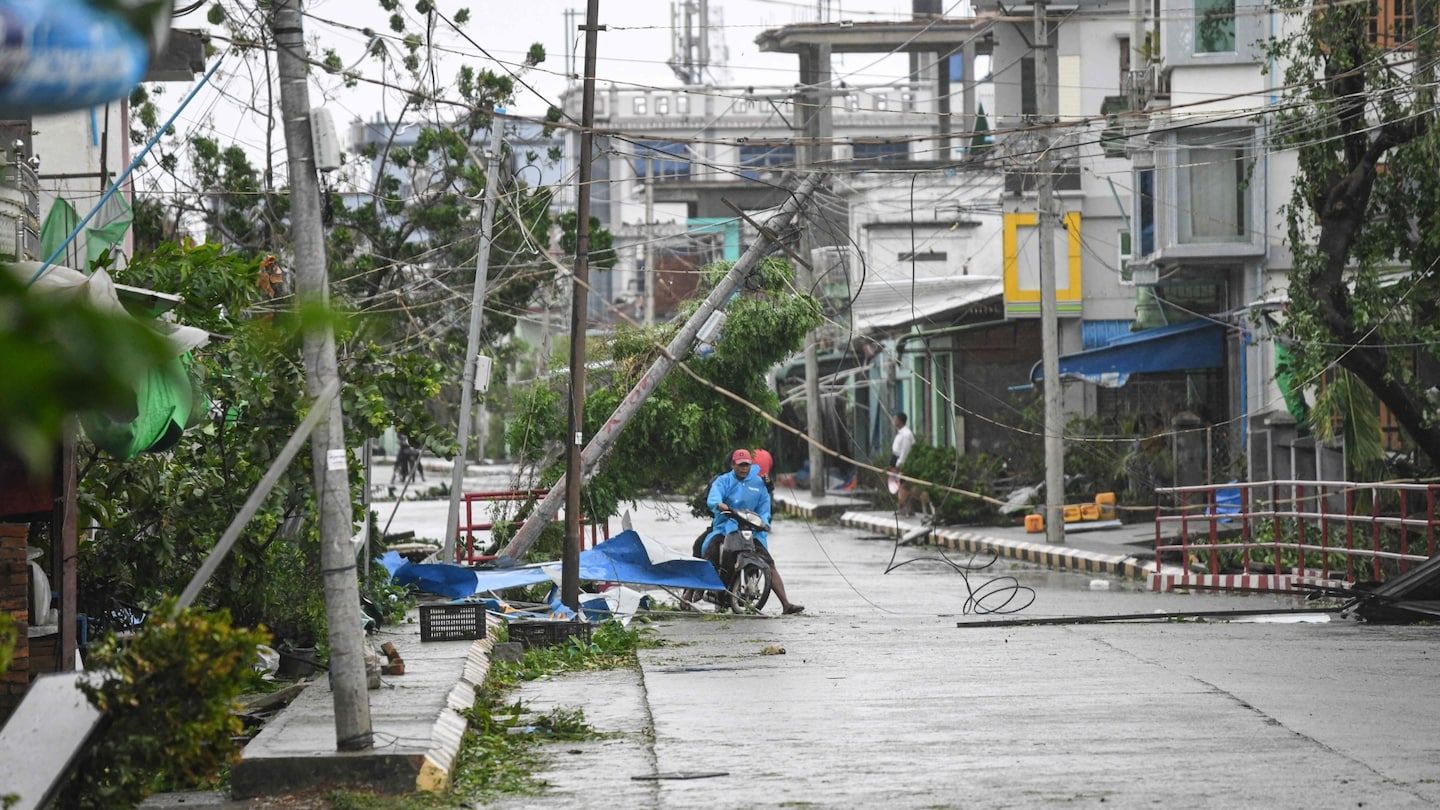Cyclone Mocha makes landfall in Myanmar, near Bangladesh
Listen 6 min Comment on this story Comment Gift Article Share
An extremely severe cyclonic storm made landfall in western Myanmar midafternoon Sunday local time, bringing dangerous storm surge, thrashing winds and heavy rains to areas of that country and Bangladesh where some of the world’s most vulnerable communities live. Landslides and floods are expected to worsen the impact of the storm — one of the strongest to strike the Bay of Bengal in recent years.
Authorities and international organizations had prepared for days for Cyclone Mocha’s arrival. The storm hit near Sittwe in northern Myanmar early Sunday afternoon local time, with around 155-mph sustained winds, according to the Joint Typhoon Warning Center. This is a high-end Category 4 equivalent; Category 5 begins at 157 mph.
Cities and towns on the northern coast of Myanmar and southeastern coast of Bangladesh were experiencing heavy to extremely heavy downpours and winds of up to 100 mph Sunday afternoon, according to India’s Meteorological Department. Unverified social media videos showed devastating wind gusts ripping tin roofs off homes and toppling a communication tower.
Advertisement
Significant storm surge has flooded large parts of the city, as seen on video posted to social media. The storm surge in the hardest-hit spots was likely near or over 5 meters (16 feet) deep. It was accompanied by building-toppling and foliage-stripping winds near the coast.
The storm caused huge damage to houses on St. Martin’s Island, Bangladesh, said Mozibur Rahman, a local government representative.
“Between 1,000 and 1,200 houses have been damaged here. The roof of many eco cottages had their roofs blown off and most trees had fallen,” he said.
Rainfall of 5 to 10 inches will be widespread near the coast and several hundred miles inland. Some locations could pick up as much as 15 inches, which could cause widespread inland flooding through early week.
Titon Mitra, a representative of the U.N. Development Program in Myanmar, tweeted Sunday that 2 million people were “at risk” because of the storm. “Damage and losses are expected to be extensive,” he added.
Satellite imagery from May 14 showed Cyclone Mocha as it approached Myanmar's coast. (Video: CIRA/CSU/EUMETSAT via Storyful)
However, some signs on Sunday indicated Cyclone Mocha could be less damaging than the most extreme predictions feared. Early reports indicate the worst missed Cox’s Bazar in Bangladesh, where up to a million refugees are in camps across the area.
Advertisement
India’s Meteorological Department said the system was “weakening” and would transform from an “extremely severe cyclonic storm” to a “very severe cyclonic storm” in the afternoon. And meteorological authorities said the risks facing Bangladesh had “reduced to a great extent” after the storm appeared to veer from the country and toward northeast Myanmar, the Associated Press reported.
Rahman on St. St. Martin’s Island said the storm had slowed down by 3:30 p.m. local time, and AKM Nazmul Haque of the Bangladesh Meteorological Department said the cyclone had mostly crossed the Bangladesh coast by 6 p.m.
ESCS MOCHA located near Lat 20.5N and Lon 92.9E at 1430 IST, about 40 km north of Sittwe(Myanmar) and 145 km southeast of Cox’s Bazar (Bangladesh). The system is continuing the weakening trend and will weaken into a very severe cyclonic storm during next 3 hours. @WMO pic.twitter.com/qLWDmNAnPU — India Meteorological Department (@Indiametdept) May 14, 2023
While Cyclone Mocha made landfall as a strong Category 4 storm, it had reached Category 5 — the highest level on the scale — about 12 hours earlier, peaking early Sunday local time with sustained winds of 175 mph and gusts as high as 200 mph. That generated waves greater than 50 feet high near the storm’s center. Even though the winds slightly weakened before reaching land, the storm surge — a rise in sea level associated with the cyclone — from its time as a Category 5 storm probably affected the shore.
Advertisement
Peak winds of 175 mph, or 150 knots, ties Mocha as the strongest in the Bay of Bengal during the satellite era (since 1982), and likely one of the strongest on record in the region all time. Although landfall winds will be reassessed in post-analysis, it probably at least ties with Cyclone Giri in 2010 as Myanmar’s strongest landfall in recorded history.
Historically, a storm like this has ended up killing hundreds to thousands or more people. Assessment of the true scale will probably take at least days to a week.
Local media outlets reported injuries and some deaths in surrounding areas in Myanmar and Bangladesh. The Washington Post could not independently verify the reports.
Still, officials were braced for what recovery will take. Some 6 million people were already in need of humanitarian assistance in the four areas of Myanmar expected to be most impacted by the storm. Rakhine, Chin, Magway and Sagaing are home to about 1.2 million displaced people, according to the U.N. humanitarian agency.
Advertisement
Some 300,000 people in Bangladesh had been evacuated ahead of the storm as of noon Sunday, local authorities said. The figure excludes Rohingya refugees, who have been moved to safer places within camps.
Myanmar’s junta government said that more than 78,000 people had been moved in Rakhine state and nearby areas as of Saturday. (A major militia in Rakhine, where there has been a long-standing insurgency, told local reporters that about 100,000 residents were moved in recent days.)
Aid agencies working in the southeastern Bangladeshi city of Cox’s Bazar, home to Kutupalong, the world’s largest refugee encampment, prepared shelter materials and health-care supplies and warned of devastating consequences for refugees living in flimsy bamboo homes.
Shortly after noon, the weather had turned choppy in Teknaf, outside Cox’s Bazar. Wind and rain gathered speed as trees convulsed.
Advertisement
“Trees and tin roofs of the houses are being blown away. But there is no tidal surge yet,” Nurul Haque, who lives on nearby St. Martin’s Island, said by phone. The island of some 10,000 people was forecast to be in the cyclone’s path.
As the storm began to hit Cox’s Bazar Sunday afternoon, Abdusattor Esoev, Bangladesh chief of mission for the International Organization for Migration, said that “almost a million Rohingya refugees” and others in Cox’s Bazar district were at risk.
“These communities are likely to face the brunt of the cyclone,” Esoev said, adding that the “temporary shelters, facilities and infrastructure refugees have been provided are likely to be flooded and severely damaged due to the winds and rains.”
The U.N. refugee agency has stockpiled supplies of dry food, and relief agencies can provide 50,000 hot meals daily if needed, it said in a statement. The World Health Organization has ambulances and mobile medical teams on standby in the area.
Advertisement
In Myanmar, the World Food Program has prepared food supplies to cover the needs of more than 400,000 people in Rakhine state and neighboring areas for a month, the agency said in a statement.
The areas impacted are “burdened by conflict, poverty, and weak community resilience,” said Sheela Matthew, WFP’s deputy director for Myanmar.
“They simply cannot afford another disaster,” she added.
Cyclone Nargis, which struck Myanmar in 2008, killed nearly 85,000 people and displaced many more.
Experts say climate change is probably making tropical cyclones more intense globally.
Azad Majumder in Dhaka, Bangladesh, Mohammad Faruque in Teknaf, Bangladesh, and Cape Diamond in Yangon, Myanmar, contributed to this report.
GiftOutline Gift Article
Source: The Washington Post


